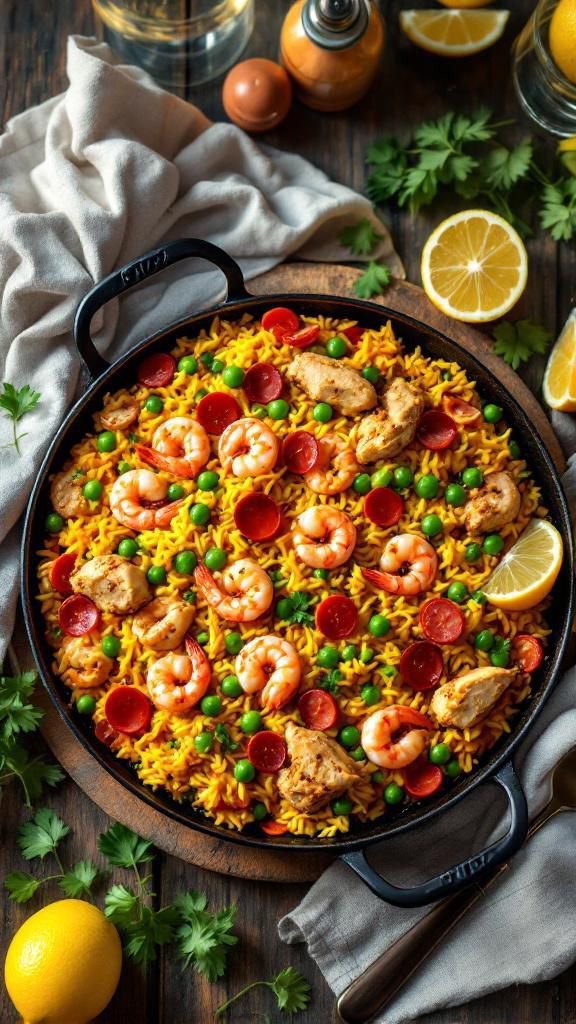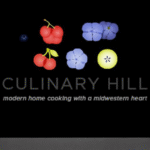I. Introduction:
A Culinary Icon Shares Sunshine For over four decades, Mary Berry CBE has been Britain’s trusted guide in the kitchen. Trained at Paris’s prestigious Le Cordon Bleu, Mary began as a magazine cookery editor before publishing her first of over 70 best-selling cookbooks in 1966. Her warmth and no-nonsense expertise made her the beloved judge on The Great British Bake Off. Awarded the Guild of Food Writers Lifetime Achievement Award (2009) and a CBE (2012), Mary champions simple techniques with quality ingredients. Her approach transforms everyday meals into something special.
Paella, Spain’s vibrant rice dish bursting with saffron, seafood, and smoky paprika, embodies comforting, communal eating. While traditionally cooked over open flames, Mary Berry’s genius lies in making iconic dishes like paella achievable for the home cook without sacrificing flavour. This recipe reflects her signature style: clear instructions, reliable results, and deliciousness. We’ll explore its history, provide Mary’s method (with helpful images!), offer a vegan twist, nutritional facts, and expert tips to ensure your success.
II. Mary Berry’s Approach & Paella’s Rich History
Mary Berry’s cooking philosophy centres on quality ingredients treated simply. For her paella, this means using:
- Good Stock: Homemade fish or chicken stock is ideal; if using store-bought, choose a strong, low-salt variety.
- Authentic Spices: Genuine saffron threads and smoked paprika (pimentón) are non-negotiable for depth and colour.
- Proper Rice: Short-grain paella rice (like Bomba or Calasparra) absorbs stock beautifully without becoming mushy.
A Brief History of Paella:
Originating in Valencia, Spain, paella’s roots are humble. Field workers cooked rice with readily available ingredients – rabbit, snails, beans, and saffron – over wood fires in wide, flat pans (“paelleras”). The name “paella” comes from the Old French/Valencian word for pan. As it spread along Spain’s coast, seafood became prominent. By the 19th century, it was a national icon. Reputable sources like the Real Academia de Gastronomía document its evolution from rustic farm meal to globally celebrated dish.
Mary’s Touch: Mary Berry honours paella’s spirit – vibrant flavours and communal joy – while adapting it for the modern kitchen. She simplifies the protein mix (often using chicken and prawns), focuses on achievable techniques, and ensures consistent results. Her version captures the sunny essence of Spain through those essential quality ingredients.
III. Ingredients & Equipment: Gather Your Essentials
Quality matters – it makes the difference between good and great paella.
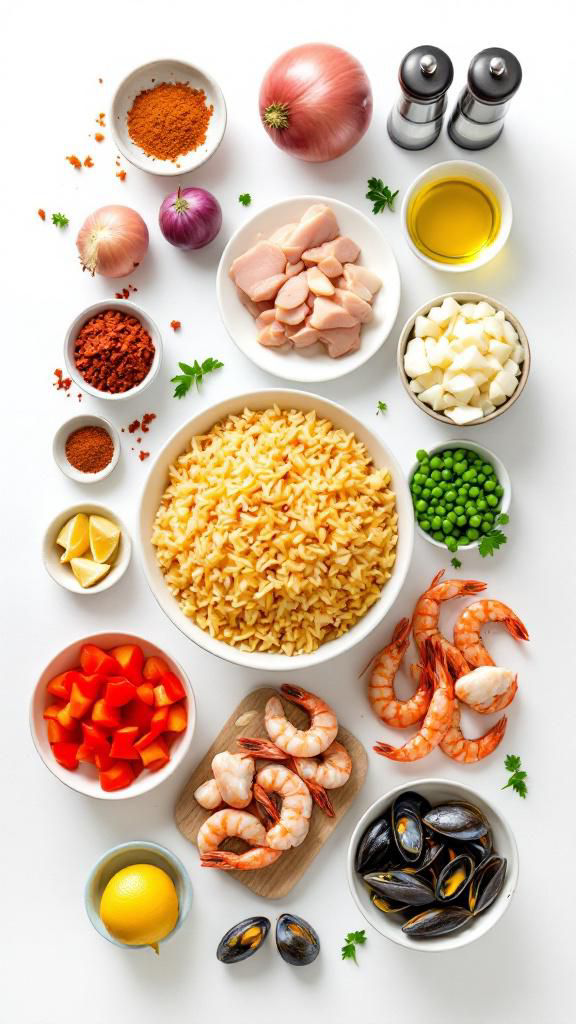
Ingredients (Serves 4-6):
- 2 tbsp good quality olive oil (like extra virgin)
- 1 large onion, finely chopped
- 1 red pepper, deseeded and chopped
- 2 garlic cloves, crushed
- 150g chorizo (cooking chorizo, not raw), sliced into thin half-moons (ensure it’s gluten-free if needed)
- 300g boneless, skinless chicken thighs, cut into bite-sized pieces
- 1 tsp smoked paprika (pimentón dulce – sweet variety)
- A generous pinch of saffron threads (about 0.5g), crushed
- 300g paella rice (Bomba or Calasparra are best; Arborio can substitute)
- 1.2 litres (about 5 cups) hot chicken or fish stock (homemade preferred, or low-salt good quality stock)
- 150g frozen peas
- 200g raw king prawns, peeled and deveined (tails on for looks if preferred)
- 100g cooked mussels (optional, but traditional)
- Lemon wedges, to serve
- Salt and freshly ground black pepper, to taste
- Fresh flat-leaf parsley, chopped (for garnish)
Essential Equipment:
- Large Paella Pan or Shallow Frying Pan/Sauté Pan (30-35cm diameter): A wide, shallow pan is crucial for the rice to cook evenly and develop the prized “socarrat” (crispy bottom layer). A large, heavy-based skillet works if you don’t have a paella pan.
- Sharp Knife & Chopping Board
- Wooden Spoon or Spatula
- Measuring Jug
- Small Bowl (for crushing saffron)
- Tin Foil or Clean Tea Towel (for resting)
IV. Recipe Instructions
Sauté Aromatics & Chorizo: Heat the olive oil in the large paella pan over medium heat. Add the chopped onion and red pepper. After this, Cook gently for 8-10 minutes until softened but not browned. Add the crushed garlic and sliced chorizo. Cook for another 2 minutes until the chorizo releases its oils and the garlic is fragrant.

Brown the Chicken: Increase the heat slightly. Add the diced chicken thighs to the pan. Season lightly with salt and pepper. Cook, stirring occasionally, for 5-6 minutes until the chicken is lightly golden all over.
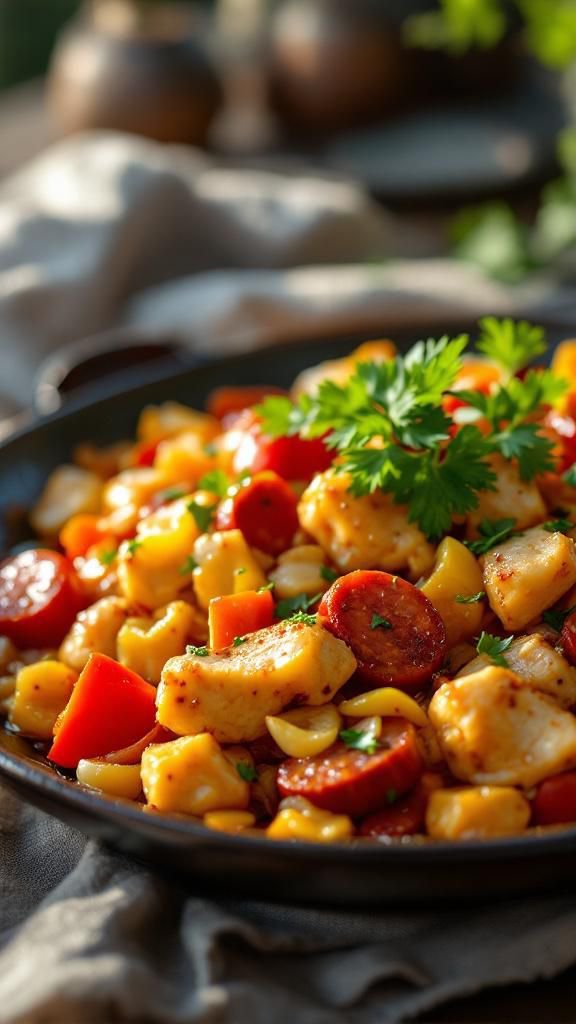
Add Spices & Rice: Stir in the smoked paprika and the crushed saffron threads. Cook for 1 minute, stirring constantly, to release their flavours. Add the paella rice. Stir thoroughly for about 2 minutes until every grain is coated in the oil and spices, becoming slightly translucent at the edges.
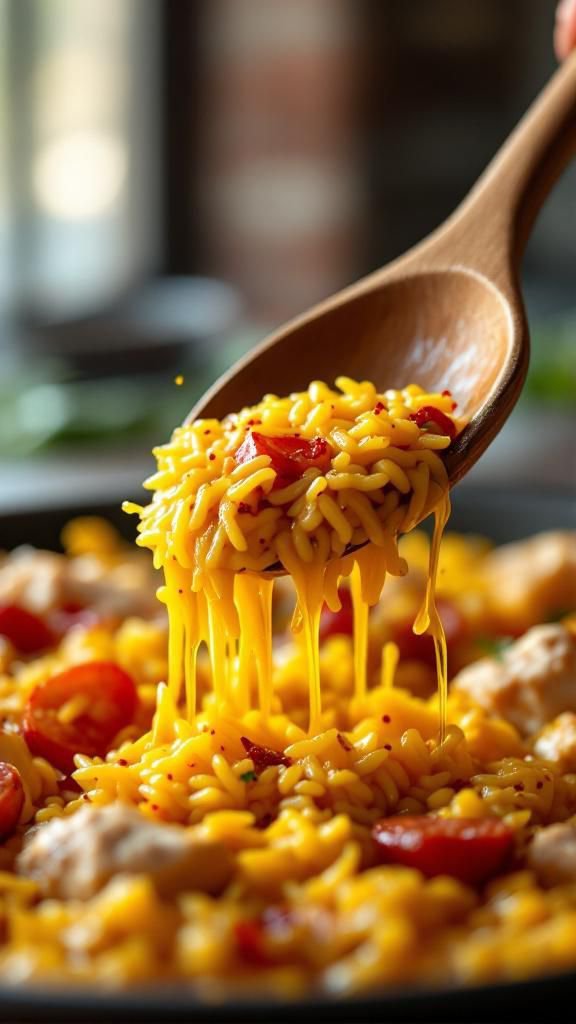
Pour in the Hot Stock: Carefully pour in all the hot stock. Give it one good stir to distribute everything evenly. Do not stir again after this point. This is key for developing the socarrat. Season lightly with salt (remember chorizo and stock add salt). Bring the mixture to a gentle simmer.
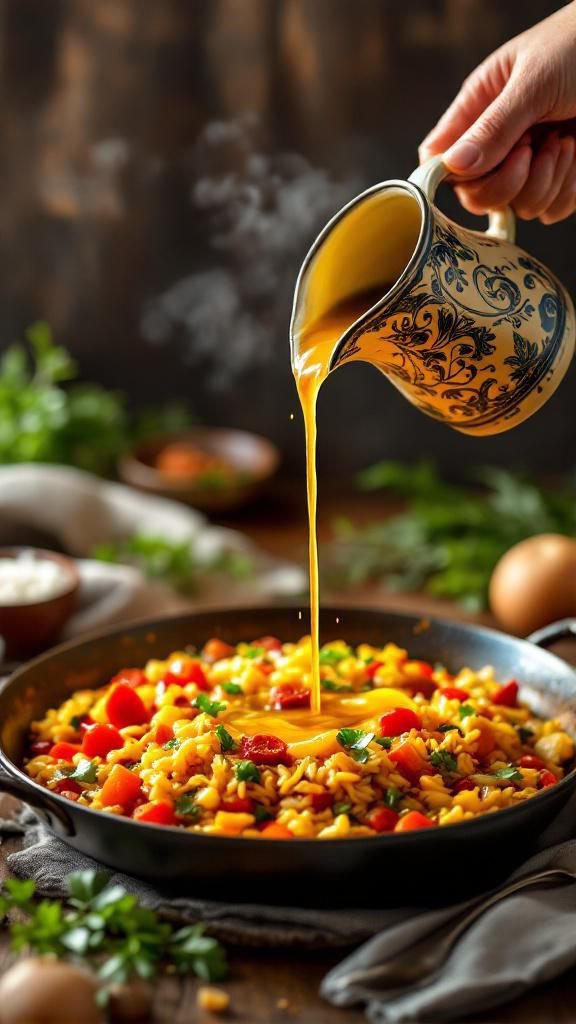
Simmer Undisturbed: Reduce the heat to low-medium (a steady, gentle bubble). Let the paella cook undisturbed for 15 minutes. The liquid will gradually be absorbed by the rice. Resist the urge to stir!
Add Seafood & Peas: After 15 minutes, the rice should be almost cooked and most liquid absorbed (it will still look quite wet). Scatter the frozen peas, raw prawns, and cooked mussels (if using) evenly over the surface of the rice. Gently press the prawns and mussels slightly into the rice.
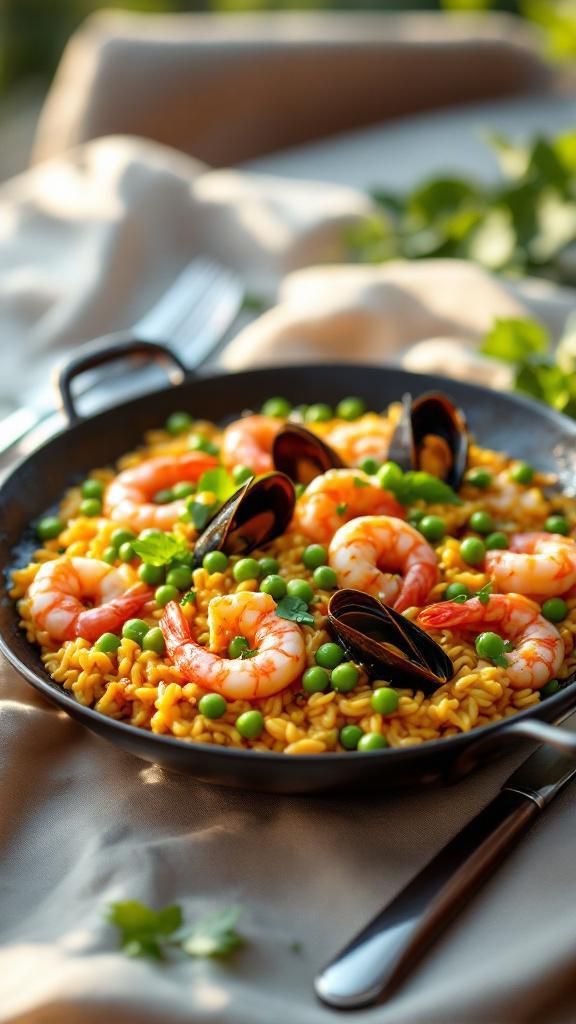
Final Cook: Continue cooking gently for another 5-8 minutes, or until the prawns are pink and cooked through, the mussels are heated, the peas are tender, and the rice is cooked. The liquid should be almost completely absorbed. If the rice seems too firm but the liquid is gone, sprinkle a tiny amount of hot water or stock over the top.
Rest & Serve: Remove the pan from the heat. Cover loosely with tin foil or a clean tea towel. Let the paella rest for 5 minutes. This allows the rice to finish absorbing any remaining moisture and the flavours to meld. Garnish generously with chopped parsley and serve immediately with lemon wedges for squeezing over.

V. Flavor Profile & Nutritional Information
Flavour Profile: Mary Berry’s paella delivers a symphony of Spanish flavours. The base is savoury and aromatic from onion, pepper, garlic, and paprika. Rich chorizo adds smokiness and depth. Saffron provides its unique floral earthiness and golden hue. The chicken and seafood offer savoury-sweet protein, while peas add freshness. The rice absorbs all these flavours, with the coveted crispy bottom (“socarrat”) adding a delightful textural contrast. Lemon juice brightens everything perfectly.
Nutritional Information (Per Serving, based on 5 servings):
- Calories: ~650 kcal
- Fat: ~25g (Saturated Fat: ~7g)
- Protein: ~40g
- Carbohydrates: ~65g
- Fiber: ~4g
- Sugar: ~4g
- Salt: ~1.8g (highly dependent on stock and chorizo used – use low-salt options to reduce)
VI. Tips for Perfect Mary Berry Paella
- Socarrat Success: Don’t stir after adding the stock! Use the right heat (gentle simmer) and pan size. Listen for a faint crackling sound near the end of cooking. If it doesn’t form naturally, increase the heat slightly for the last 1-2 minutes (watch carefully!).
- Rice Right: Don’t rinse paella rice – the starch helps create the creamy texture. Use Bomba if possible; it absorbs nearly triple its volume in liquid without overcooking.
- Stock is King: Homemade stock makes a huge difference. If using store-bought, use a high-quality, low-salt version. Heat it before adding.
- Don’t Overcook Seafood: Add prawns and mussels late to prevent them becoming tough and rubbery.
- Resting is Crucial: Those 5 minutes off the heat let the rice finish cooking evenly and absorb any excess moisture.
- Variations:
- Mixed Seafood: Add calamari rings or small scallops with the prawns.
- Vegetable Boost: Stir in sliced green beans or artichoke hearts with the peas.
- Lemon Zest: Add grated lemon zest with the parsley garnish for extra zing.
VII. Vegan Paella Variation
Enjoy the vibrant flavours of paella without animal products.
Ingredients:
- 3 tbsp olive oil
- 1 large onion, chopped
- 1 red pepper, chopped
- 1 green pepper, chopped
- 3 garlic cloves, crushed
- 1 tsp smoked paprika
- Generous pinch saffron threads, crushed
- 300g paella rice
- 1.2 litres hot vegetable stock
- 1 x 400g tin chopped tomatoes
- 1 tsp dried oregano
- 150g green beans, trimmed & halved
- 150g frozen peas
- 1 x 400g tin artichoke hearts, drained & quartered
- 100g roasted red peppers (jarred), sliced
- Salt & pepper
- Lemon wedges & parsley to serve
Instructions:
- Follow steps 1 & 2 from the main recipe, using olive oil and sautéing onion and both peppers until soft. Add garlic.
- Stir in paprika and saffron, cook 1 min. Add rice, stir to coat (2 mins).
- Pour in the hot vegetable stock and add the tinned tomatoes and dried oregano. Stir once, season lightly, bring to a simmer. Cook undisturbed for 15 mins.
- Scatter the green beans, peas, artichoke hearts, and roasted red peppers evenly over the rice. Press gently into the liquid.
- Continue cooking for 8-10 mins until rice is tender, beans are cooked, and liquid is absorbed.
- Rest for 5 mins, covered. Garnish with parsley and serve with lemon wedges.
VIII. Recipe Variations & Serving Suggestions
- Classic Valencian: Omit seafood and chorizo. Use chicken thighs, rabbit pieces, and butter beans or garrofó (lima beans). Add a sprig of rosemary.
- Seafood Feast: Increase prawns, add mussels, clams, calamari, and chunks of firm white fish. Use fish stock.
- Serving Ideas: Paella is a complete meal! Serve straight from the pan. Accompany with:
- A simple green salad with lemon vinaigrette.
- Crusty bread for mopping up juices.
- A glass of Spanish white wine (Albariño) or rosé.
IX. Storage & Reheating Instructions
- Storage: Cool completely within 2 hours. Transfer to an airtight container. Refrigerate for up to 2 days. Seafood paella is best eaten fresh.
- Reheating: The best method is on the stovetop. Add a small splash of stock or water to the paella in a pan. Cover and heat gently over low-medium heat, stirring occasionally, until piping hot throughout (5-10 mins). Microwaving can make rice mushy and seafood rubbery – if using, sprinkle with water, cover loosely, and heat on medium power in short bursts, stirring gently.
X. Frequently Asked Questions (FAQ)
- Can I use regular long-grain rice? Not recommended. Paella rice (like Bomba) absorbs more liquid and stays firm. Arborio (risotto rice) is the best substitute.
- My rice is crunchy/undercooked? You likely needed more liquid or heat was too high. Next time, ensure stock is hot, simmer gently, and if rice is still firm near the end, add small splashes of hot water/stock.
- My rice is mushy? You stirred too much after adding stock, used the wrong rice, had too much liquid, or heat was too low. Don’t stir after adding stock and use Bomba/Arborio.
- Where do I find saffron? Good supermarkets, delis, or online spice merchants. Look for deep red threads. Avoid cheap ground saffron – it’s often adulterated.
- Can I make it ahead? Paella is best served immediately. The texture changes on reheating, especially with seafood. Prep ingredients ahead but cook just before serving.
- Can I freeze paella? Freezing is not recommended. The rice texture becomes very grainy and unpleasant upon thawing and reheating.
- What if I don’t have a paella pan? A large (30-35cm), heavy-based, shallow frying pan or sauté pan is the next best thing. Avoid deep pots.
XI. Conclusion & Call to Action
Mary Berry’s paella recipe brings the vibrant soul of Spain into your kitchen with achievable elegance. It’s a celebration of simple, quality ingredients combined with a relaxed, communal spirit – hallmarks of Mary’s beloved cooking style. The golden rice, infused with saffron and smoky paprika, studded with savoury chicken, chorizo, and juicy prawns (or colourful veggies in the vegan version), is guaranteed to impress family and friends.
Ready to bring sunshine to your table? Give Mary’s paella a try this weekend! Share your culinary triumph – tag us on social media ([@YourWebsiteHandle]) and tell us how it turned out. Did you get that perfect socarrat? What variations did you love? We’d love to see your photos and hear your feedback! See more healthy recipes
XII. Additional Resources
- Mary Berry’s Official Website & Cookbooks: Discover more recipes and her latest books directly: Mary Berry Official Website
- Mary Berry’s Bestselling Cookbooks: Find her extensive collection, including Mary Berry Cooks, Absolute Favourites, and Baking Bible: Mary Berry Cookbooks
- History of Paella: Learn more about this iconic dish from reputable sources:
- Real Academia de Gastronomía (Spain) (Spanish)
- The Paella Club (Valencia) (English)
